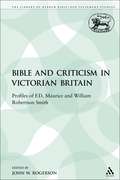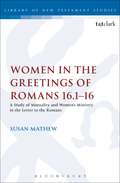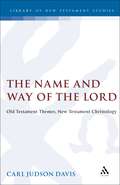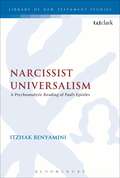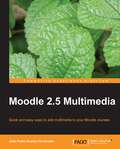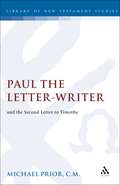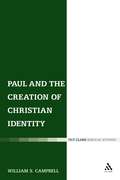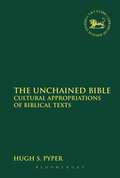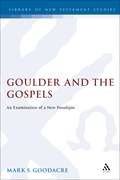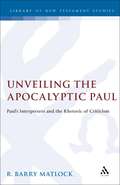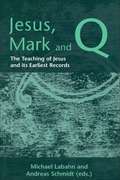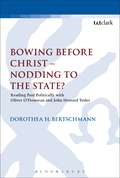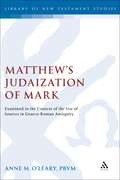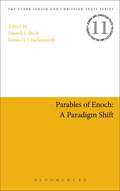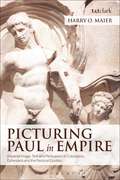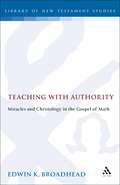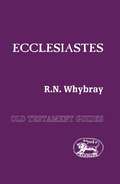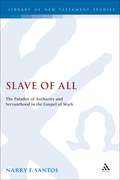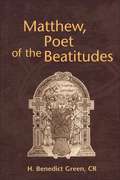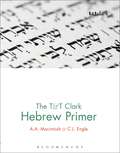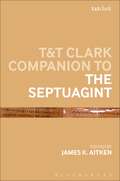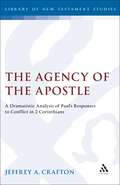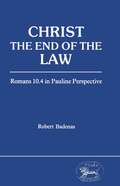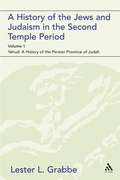- Table View
- List View
The Bible and Criticism in Victorian Britain: Profiles of F.D. Maurice and William Robertson Smith (The Library of Hebrew Bible/Old Testament Studies)
by John W. RogersonThis book contains the F.D. Maurice lectures for 1992 and six Gifford lectures of 1994. The Maurice lectures present the first account of Maurice as an Old Testament interpreter. The lectures on Smith concentrate upon his theological interests as an interpreter of the Bible, as well as the first account based on unpublished material of Smith's activity as a preacher. There is also a close investigation of Smith's links with Germany, and the influence upon him of Richard Rothe is investigated in some detail for the first time. One of the aims of the book is to show how, in their different ways, Maurice and Smith tried to relate the Old Testament to the two different periods of Victorian Britain in which they lived. The book also is intended as a further contribution to our knowledge of the history of biblical criticism in Britain.
Women in the Greetings of Romans 16.1-16: A Study of Mutuality and Women's Ministry in the Letter to the Romans (The Library of New Testament Studies #471)
by Susan MathewSusan Mathew examines the structures of mutuality in Romans, to shed light on the issue of women's leadership in Pauline theology. Mathew begins by analyzing the general form of greetings in the Pauline letters, to shed light on the specific form of the greetings in Rom 16.1-16. Mathew then couples this with analysis of the leadership of women in the Greco-Roman world showing that women's leadership roles in the Pauline churches were part of this wider culture. This provides a basis from which to show that the women named in Romans 16.1-16, display Paul's acknowledgment of some women associates, and point to relationships of mutuality in the greetings. A study of Romans 12-13 helps to apprehend the model of mutuality exemplified in the greetings. Finally, the contextual application of mutuality in the community as mutual welcoming and mutual up-building (Romans 14-15) is brought into focus. This enables Mathew to draw together the strands of the Pauline ethos of mutuality, which encourages the leadership roles of women in the greetings at the end of Romans.
The Name and Way of the Lord: Old Testament Themes, New Testament Christology (The Library of New Testament Studies #129)
by Carl Judson DavisThis book discusses the first-century implications of applying Old Testament texts about the divine to Jesus. It summarizes recent views on the significance of this practice. It then collects pre-Christian and first-century Jewish parallels, and notices that most centre on the angel, wisdom, glory and word of the Lord, although application to non-divine figures also occurs. The evidence is that some Christians in the 50s worked with a redefinition of monotheism in which they included the Father and Jesus. Such a view explains the New Testament salvation-historical perspective in regard to the Old Testament belief on the theophany of God and the belief in God as the object of invocation.
Narcissist Universalism: A Psychoanalytic Reading of Paul's Epistles (The Library of New Testament Studies #453)
by Itzhak BenyaminiFor several decades Paul's epistles have been right at the focus of academic and philosophic debate regarding the questions pertaining to Jewish law; love in relation to the law; the linkage between Judaism and Christianity, and so on. What do Paul's writings consist of that can be used as a key for understanding Western Culture? Itzhak Benyamini seeks to re-read Paul's epistles using a critical psychoanalytical approach in light of Jacques Lacan's theory, in order to find which unconscious core this text provides us with. Benyamini examines Paul's use of Christian ritual and concomitant authoritative evocation of the Biblical tenet Love thy Neighbor, in order to establish a communal Christian identity, separate from 'carnal' Judaism and idolatry alike. According to Benyamini, Paul has founded a narcissist community of sons who place the Son at the centre of their existence. Consequently, the Christian Imaginary is juxtaposed as an alternative to pagan-carnal pleasure - but also as alternative to Judaic law.
Moodle 2.5 Multimedia
by Joao Pedro SoaresFernandesA tutorial-based guide where readers can work through practical examples that clearly describe how to create multimedia applications using Moodle and integrate existing multimedia resources into Moodle courses.If you are a teacher or trainer who runs online courses and has a basic understanding of Moodle, this book will be ideal for you. It is not necessary to have an advanced technical background to create multimedia elements as the tasks will be simple, not time consuming, and will be practical for everyday use.
Paul the Letter-Writer and the Second Letter to Timothy (The Library of New Testament Studies #23)
by Michael PriorThis study argues for new perspectives on the letters of Paul, especially the Second Letter to Timothy. It examines striking aspects of Paul's letters, especially the fact that many of them are co-authored, that six of them acknowledge that a secretary has penned the letter, and that 1 Timothy, 2 Timothy and Titus are the only ones addressed to individuals. It investigates the implications of these facts for the concept of Pauline authorship. Prior maintains that the received arguments, statistical as well as literary, which exclude 2 Timothy from the influence of Paul, are less than convincing. The author suggests an original reading of 2 Timothy arguing it was composed by Paul towards the end of his first Roman imprisonment. Contrary to all interpretations of the letter which argue that Paul was about to be martyred, Prior claims that Paul was confident that he would be released, and was assembling a mission team to bring his proclamation of the Gospel to a completion. Timothy's courage and missionary zeal needed rekindling, for he and Mark were to be key figures in this new team.
Paul and the Creation of Christian Identity: Paul And The Creation Of Christian Identity (The Library of New Testament Studies #322)
by William S. CampbellIn the dominant interpretation of the Antioch incident Paul is viewed as separating from Peter and Jewish Christianity to lead his own independent mission which was eventually to triumph in the creation of a church with a gentile identity. Paul's gentile mission, however, represented only one strand of the Christ movement but has been universalized to signify the whole. The consequence of this view of Paul is that the earliest diversity in which he operated and which he affirmed has been anachronistically diminished almost to the point of obliteration. There is little recognition of the Jewish form of Christianity and that Paul by and large related positively to it as evidenced in Romans 14-15. Here Paul acknowledges Jewish identity as an abiding reality rather than as a temporary and weak form of faith in Christ. This book argues that diversity in Christ was fundamental to Paul and that particularly in his ethical guidance this received recognition. Paul's relation to Judaism is best understood not as a reaction to his former faith but as a transformation resulting from his vision of Christ. In this the past is not obliterated but transformed and thus continuity is maintained so that the identity of Christianity is neither that of a new religion nor of a Jesus cult. In Christ the past is reconfigured and thus the diversity of humanity continues within the church, which can celebrate the richness of differing identities under the Lordship of Christ.
The Unchained Bible: Cultural Appropriations of Biblical Texts
by Hugh S. PyperThis volume explores a number of instances of unexpected but influential readings of the Bible in popular culture, literature, film, music and politics. The argument in all of them is that the effects of the Bible continues to have an effect on contemporary culture in ways that may surprise and sometimes dismay both religious and secular groups. That the Bible was at one time chained in churches is true. The subversive misreading of this enchainment as a symbol of a book in captivity to the established church is hard to suppress, however. Yet, once released from these chains, the Bible proves to be a text that gets everywhere and which undergoes surprising and sometimes contradictory metamorphoses. The pious advocates of making the Bible accessible who sought to free it from the churches' chains are the very people who then decry some of the results when the Bible is free to roam.
Goulder and the Gospels: An Examination of a New Paradigm (The Library of New Testament Studies #133)
by Mark GoodacreGoulder and the Gospels is the first comprehensive response to the radical challenge Michael Goulder has posed for New Testament scholarship. Goulder dispenses with all hypothetical sources-Q, M and L and postulates highly creative evangelists who write in the light of the liturgy. In this penetrating critique, Goodacre provides a critical overview of Goulder's work, focusing on several key areas, the vocabulary of Q, the language of the Minor Agreements, the creativity of Luke and the lectionary theory. He does not simply assess the plausibility of Goulder's ideas but also develops new ways to test them. The theories are sometimes found to be wanting, but at the same time Goulder is reaffirmed as one of the most important and stimulating Biblical scholars of this generation.
Unveiling the Apocalyptic Paul: Paul's Interpreters and the Rhetoric of Criticism (The Library of New Testament Studies #127)
by R. Barry Matlock'Apocalyptic' is a key concept for 20th century interpretation of Paul, embracing several major figures and strands of inquiry. But the category 'apocalyptic' has itself of late come in for scrutiny, which in turn reflects back on 'apocalyptic' interpretation of Paul. This study offers a review of interpretation, ranging beyond Pauline studies to address 'apocalyptic' interpretation generally. Sustained attention to what interpreters are doing with this category, placed alongside what is claimed as being done, reveals a hermeneutical story of considerable interest and wide relevance, which situates the whole interpretive dialogue.
Sacred Space: An Approach to the Theology of the Epistle to the Hebrews (The Library of New Testament Studies #73)
by Marie IsaacsThe author of Hebrews is not preoccupied with the concepts of the Hellenistic philosophers but with the ideas of the ancient world is frequently conveyed by the notion of 'sacred space', which the worshipper wishes to approach in order to gain access to the deity. Standing as he does within the religious tradition of Judaism, the author of Hebrews inherited notions of sacred space whereby it was identified with the land, Jerusalem, Zion and the sanctuary. He shares priestly concern, so Isaacs argues, to guard the sacred, to protect it from the profane, and to regulate the means whereby the worshipper can approach the holy.
Jesus, Mark and Q: The Teaching of Jesus and Its Earliest Records (The Library of New Testament Studies #214)
by Michael Labahn Andreas SchmidtThe first part of this collection is devoted to one of the key questions of the 'Synoptic Problem': the literary and christological relationship between Mark and Q. The second part deals with the 'Third Quest' for the historical Jesus, concentrating on his teaching and its cultural context. These interrelated themes each attract detailed analysis of their methodology as well as their impact on New Testament studies generally, providing a very useful introduction to the state of research in these important fields.
Bowing before Christ - Nodding to the State?: Reading Paul Politically with Oliver O'Donovan and John Howard Yoder (The Library of New Testament Studies #502)
by Dorothea H. BertschmannDoes the apostle Paul sponsor political conservatism? A growing number of scholars dispute this perception, arguing that Paul's political imagery and in particular the confession that "Jesus Christ is Lord" directly challenge the proud Roman emperor.This book critically engages these proposals, seeking to point out with greater precision the function of political imagery within the Pauline narrative. Dorothea H. Bertschmann starts by conversing with the works of John Howard Yoder and Oliver O'Donovan, two modern political ethicists and theologians. She argues that both thinkers in all their distinctive emphases wrestle with a similar difficulty: How can Christ the Lord be meaningfully related to earthly lords without betraying the otherness of Christ's Lordship? But how does Paul deal with this problem? In order to answer this question Bertschmann offers a close reading of two key texts, Philippians 2:5-11 and Romans 13:1-7.She argues that despite the many-faceted political imagery of the "Christ hymn", Paul does nothing in his explicit narrative to engage existing rulers positively or negatively with the message of Christ's rule.Paul's focus is entirely on the church, which he seeks to construct as a "community under authority". While there is no emperor in the Christ hymn, there is no Christ in Paul's political admonition of Romans 13.Paul deliberately keeps political rule at the periphery of God's salvific actions in Christ, while not totally dis-connecting it from the overall divine act.This strategy has its limitations, but also the potential to offer fresh impulses in theological deliberations about "church and state".
Matthew's Judaization of Mark: Examined in the Context of the Use of Sources in Graeco-Roman Antiquity (The Library of New Testament Studies #323)
by Anne M. O'LearyCreative imitation (Gk., mimesis; Lt., imitatio) was the primary literary convention of the ancient world of the first century CE. In the first part of the book it is demonstrated that it was the principal means by which classical authors, for example, Virgil, Seneca, Plutarch, and Livy, composed their works. An examination of the use of sources in both Jewish and Christian Sacred Scriptures in the light of this convention provides a new and fruitful approach to scripture scholarship. The Book of Tobit and Paul's First Letter to the Corinthians (1 Cor 8-10) are examined to demonstrate this thesis. This sets the context for an examination of Matthew's use of Mark as a literary source in the light of Graeco-Roman literary conventions in part two of the book. Such a use is entirely plausible when one considers that, "penned in Greek, probably to Diaspora audiences, the canonical gospels reflect Greco-Roman rather than strictly Palestinian Jewish literary conventions." Both the way in which Matthew incorporates his Markan source into his text, and the function and effect of this source in its new Matthean context are examined. This methodology provides compelling evidence that Matthew's use of Mark as a source was toward the Judaization of his Gospel.
Parables of Enoch: A Paradigm Shift (Jewish and Christian Texts #Vol. 11)
by Darrell L. Bock James H. CharlesworthParables of Enoch: A Paradigm Shift is an interdisciplinary study of the state of the current debate surrounding the Parables of Enoch with regard to their dating as well as their Jewish character and their potential contribution to aspects of early Christian thought. The role of 1 Enoch in the context of Christian Origins is much discussed amongst Second Temple and New Testament scholars, with the former often attaching more importance to them than the latter. The contributors to the present volume stem from both areas, and together explore the relative signifance of the Parables of Enoch. The important issues discussed include: the significance of the parables for a deeper understanding of Second Temple thought, Jesus' message, the development of the kerygma, and the traditions embodied and edited in canonical texts, especially the Gospels. The extremely impressive list of contributors includes; Geza Vermes, Richard Bauckham, James Dunn, Larry Schiffman, James VanderKam, Francis Moloney and Loren Stuckenbruck.
Picturing Paul in Empire: Imperial Image, Text and Persuasion in Colossians, Ephesians and the Pastoral Epistles
by Harry O. MaierPauline Christianity sprang to life in a world of imperial imagery. In the streets and at the thoroughfares, in the market places and on its public buildings and monuments, and especially on its coins the Roman Empire's imperial iconographers displayed imagery that aimed to persuade the Empire's diverse and mostly illiterate inhabitants that Rome had a divinely appointed right to rule the world and to be honoured and celebrated for its dominion. Harry O. Maier places the later, often contested, letters and theology associated with Paul in the social and political context of the Roman Empire's visual culture of politics and persuasion to show how followers of the apostle visualized the reign of Christ in ways consistent with central themes of imperial iconography. They drew on the Empire's picture language to celebrate the dominion and victory of the divine Son, Jesus, to persuade their audiences to honour his dominion with praise and thanksgiving. Key to this imperial embrace were Colossians, Ephesians, and the Pastoral Epistles. Yet these letters remain neglected territory in consideration of engagement with and reflection of imperial political ideals and goals amongst Paul and his followers. This book fills a gap in scholarly work on Paul and Empire by taking up each contested letter in turn to investigate how several of its main themes reflect motifs found in imperial images.
Teaching with Authority: Miracles and Christology in the Gospel of Mark (The Library of New Testament Studies #74)
by Edwin K. BroadheadThe foundational inquiries into the relationship of miracles and Christology by Wrede, Dibelius, Bultmann and Marxsen guided a productive half-century of critical research. Their work raised crucial issues concerning the nature of the Gospels and the proper methods of interpretation that have in many ways charted the direction for New Testament studies. A new principle is now to be added to their criteria, however, that strategies of interpretation must be consciously shaped to highlight the features of narrative and its christological focus. The author then employs a consistent narrative strategy of interpretation in order to re-evaluate the relation of miracles and Christology in the Gospel of Mark. The primary goal is reconsideration of the role played by miracle stories in the characterization of Jesus. In particular, the tension posed by recent scholarship between the Jesus of the miracles and the Jesus of the cross is shown to be a false dichotomy.
Ecclesiastes (Old Testament Guides)
by R. Norman WhybrayEcclesiastes is at once a strange book and a modern one, at once enigmatic and curiously familiar. Here we find a man detached from the world and yet intensely aware of it, setting down in writing his thoughts about human life. Yet from the very first his readers have been unable to agree about his basic attitude to life. Whybray sorts through the options by asking questions regarding the author, his times, his language and his ideas.
Slave of All: The Paradox of Authority and Servanthood in the Gospel of Mark (The Library of New Testament Studies #237)
by Narry SantosThe Gospel of Mark is often described as a paradoxical gospel, a riddle that teases its readers' response, and a narrative that possesses an enigmatic and puzzling character. Santos argues that this puzzling character is seen clearly in the paradox of authority and servanthood in the gospel. In tracing and analyzing this paradox throughout the Markan narrative, he first develops a literary method for the study of paradox, and having applied the results to authority and servanthood in Mark, he discusses key contributions of the paradox to the three Markan issues of the disciples' role in the Gospel, the Messianic Secret, and a profile of the Markan community.
Matthew, Poet of the Beatitudes (The Library of New Testament Studies #203)
by H. Benedict GreenGreen argues that the Beatitudes in Matthew's version are a carefully constructed poem, exhibiting a number of the characteristics of Hebrew poetry as we know it from the Old Testament; but as certain of these, such as rhyme and alliteration, cannot survive translation, what we have here is an original composition in Greek. This is shown to be no isolated phenomenon in the gospel; a series of texts found at specially significant points in it disclose similar characteristics. The findings cut across conventional source attributions and reveal the creative hand of the evangelist. By studying the individual beatitudes in their relation to each other as revealed by the formal structure, fresh light is thrown upon their meaning and their background in the scriptures of the Old Testament.
The T&T Clark Hebrew Primer
by A. A. Macintosh C. L. EngleLearning Biblical Hebrew can be extremely difficult. Here at last is a book designed to work in conjunction with the many Hebrew Grammars available in order to break this complex language down into bite-size chunks for revision and consolidation of key aspects of grammar, as well as vocabulary. A.A. Macintosh and C.L. Engle combine insights from teaching Hebrew in both the United States and Europe, and between them bring some fifty years of experience of teaching Hebrew to undergraduate students to this clearly structured book.
T&T Clark Companion to the Septuagint (Bloomsbury Companions)
by James K AitkenThe Septuagint is the Greek translation of the Hebrew Bible and the scriptures read by early Christians. Septuagint studies have been a growth field in the past twenty years. It has become an area of interest not only for textual criticism of the Hebrew Bible but as a product of Judaism in the Graeco-Roman world. It is even being utilized occasionally by scholars of Greek religion. At the same time renewed interest in the daughter versions (Syriac, Vulgate, Ethiopic, Coptic etc.) has thrown new attention onto the Septuagint. This Companion provides a cutting-edge survey of scholarly opinion on the Septuagint text of each biblical book. It covers the characteristics of each Septuagint book, its translation features, origins, text-critical problems and history. As such it provides a comprehensive companion to the Septuagint, featuring contributions from experts in the field.
The Agency of the Apostle: A Dramatistic Analysis of Paul's Responses to Conflict in 2 Corinthians (The Library of New Testament Studies #51)
by Jeffrey CraftonIn this interdisciplinary study Paul's enigmatic rhetoric in 2 Corinthians is analysed and explained using dramatism, a modern critical theory developed by Kenneth Burke. Three portions of 2 Corinthians are isolated and examined as fitting responses to dintinct stages in Paul's changing relationship to the Corinthian Christians. In the Letter of Initial Response (2.14-7.4), Paul responds to the beginning of the conflict with an argument defined by the opposition between 'agency' and 'agent' conceptions of ministry. In the Letter of Attack (chs. 10-13), Paul replies to the apex of the crisis by playing the role of the foolish agent in order to gain a hearing and drive the Corinthians out of their orientation. In the Letter of Reconciliation (1.3-2.13 + 7.5-16), Paul rehearses the symbolic purification which has occurred in this conflict.
Christ the End of the Law: Romans 10.4 in Pauline Perspective (The Library of New Testament Studies)
by Robert BadenasIn this close textual analysis Badenas uses the term 'telos' as his starting point to delve into a closer examination of the Greek-speaking ancient world. The study divides into three key sections: a history of exegesis, a lexical study of telos, and an exegetical study of Rom 10:4. This final part enables an in-depth analysis of the place and role of Rom 10:4 within Romans 9:11, and, in turn, of Romans 9:11 within Paul's argument more generally. In so doing, Badenas is able to offer a more informed judgement of the use of the statement 'Christ is the end of the law,' contributing insightfully to an abundance of material which proclaims the statement without acknowledgement of its greater context.
A History of the Jews and Judaism in the Second Temple Period: The Persian Period (539-331BCE) (The Library of Second Temple Studies #47)
by Lester L. GrabbeIn the first of four volumes on A History of the Jews and Judaism in the Second Temple Period, Lester Grabbe presents a comprehensive history of Yehud - the Aramaic name for Judah - during the Persian Period. Among the many crucial questions he addresses are: What are the sources for this period and how do we evaluate them? And how do we make them 'speak' to us through the fog of centuries? This first volume, Yehud: A History of the Persian Province of Judah offers the most up to date and comprehensive examination of the political and administrative structures; the society and economy; the religion, temple and cult; the developments in thought and literature; and the major political events of Judah at the time.
